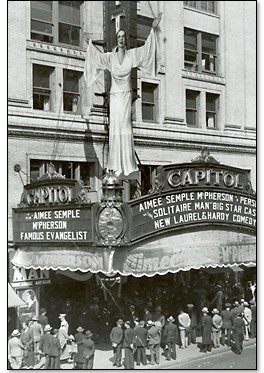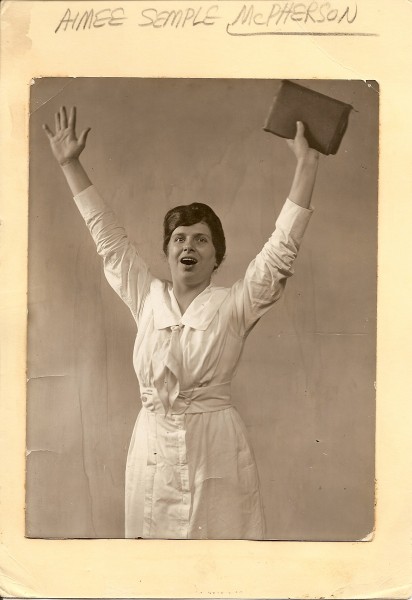
 |
|
| Aimee Semple McPherson | |
| Date of Birth | October 9, 1890 |
| Date of Death | September 27, 1944 |
| Occupation | Evangelist |
| Children | Roberta Star Semple and Rolf McPherson |
Aimee Semple McPherson (1890-1944), American evangelist, symbolized important attributes of American popular religion in the 1920s and 1930s.
Aimee Kennedy was born on Oct. 9, 1890, near Ingersoll, Ontario, Canada. Her father was a struggling farmer, her mother a former member of the Salvation Army. Aimee remained a nonbeliever until, at the age of 17, she experienced conversion under the guidance of Scottish evangelist Robert Semple. In 1908 she married him and followed him to China as a missionary. He died soon after arriving in China, leaving her penniless and with a month-old daughter. Returning home, Semple married a grocery clerk, Harold S. McPherson, in 1913; this marriage ended in divorce five years later. Thereafter she set out as an untrained lay evangelist to preach a Pentecostal-type of revivalism to the people of Ontario.


Physically attractive and possessed of a dynamic personality and instinctive ability to sway crowds, Aimee Semple McPherson gradually perfected her skills. By this time professional revivalism had achieved a distinctive style and organization; McPherson illustrated the newer tendencies. Though she initially lived an almost hand-to-mouth existence following the route of itinerant evangelists from Maine to Florida, success meant a move into larger cities in America, England, and Australia. In the cities audiences were often immense, with 10,000 to 15,000 partisans deliriously applauding her. McPherson's preaching also identified her with the "fringe" sects of American Protestantism that were especially influential among the masses in America's newly emerging urban centers. "Speaking with tongues" and successful efforts at faith healing--both practiced by the Pentecostal churches--were a part of her performance.
By 1920 McPherson was permanently established in Los Angeles. In 1923 she and her followers dedicated Angelus Temple. Seating over 5,000 people, this served as her center of activity. Backed by a shrewd business manager (her mother), the evangelist organized a private cult of devoted followers. She also became a public figure in tune with the garish, publicity-oriented life of the film capital of the world.
McPherson continued her unconventional ways until her death in Oakland, Calif., on Sept. 27, 1944. She engaged in a slander suit with her daughter, publicly quarreled with her mother, and carried on well-publicized vendettas with other religious groups.4